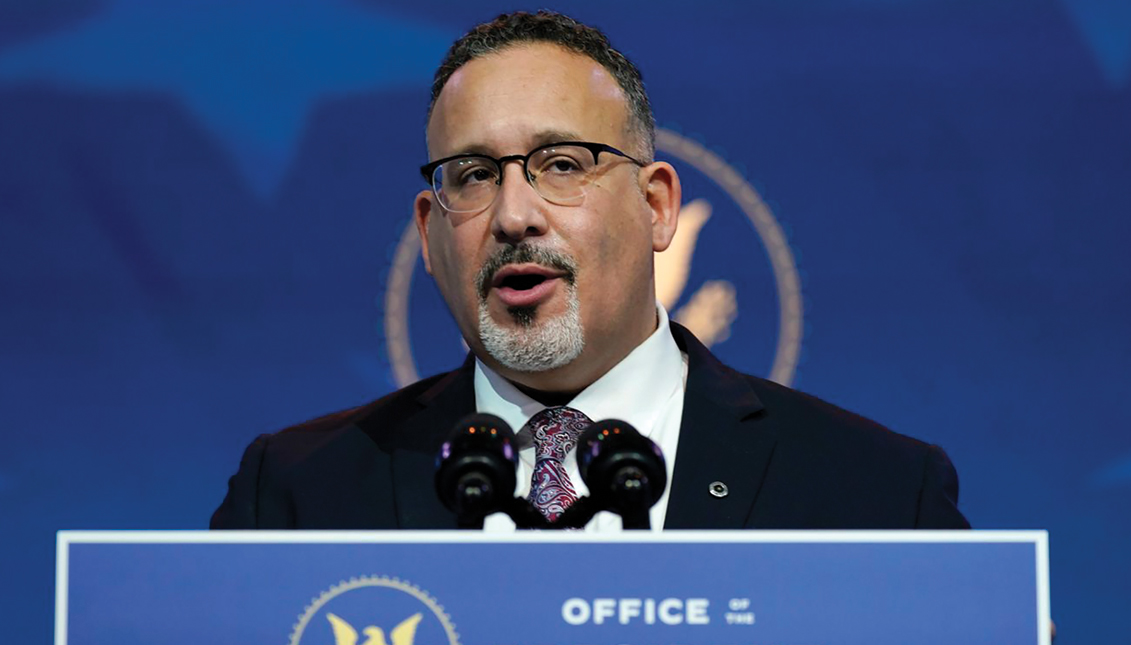
After Sec. Cardona’s $1 billion relief to defrauded students, activists call for full debt cancellation
How much authority does Sec. Miguel Cardona have over the Student Debt crisis? And what can he do to push Biden’s Promised $10k forgiveness?
At his confirmation Hearing, U.S. Secretary of Education Cardona acknowledged the racial disparities in higher education in correlation with the staggering student loan debt in the nation. While he refrained from committing to widespread student debt cancellation as progressive lawmakers and nationwide activists have called for, he promised to work towards providing measures of relief to student loan borrowers.
Just under 20 days since he was sworn-in as Secretary of Education, Cardona delivered, in part.
About 72,000 people now have their federal loans fully canceled after ending a policy instituted by Cardona’s Trump-era predecessor, Betsy DeVos. It’s his first major higher education announcement since being confirmed, wherein those affected will get their full federal loan cancellation after being defrauded by their colleges.
It reinstates the Obama administration’s practice of granting full cancellation to students when it is deemed a college committed fraud.
“Students deserve a straightforward and fair process for relief when they have been harmed by an institution's misconduct. That's why I am taking action to ensure students who have been taken advantage of get a fresh start from their debt,” Cardona wrote on Twitter.
Students deserve a straightforward and fair process for relief when they have been harmed by an institution's misconduct. That's why I am taking action to ensure students who have been taken advantage of get a fresh start from their debt. https://t.co/oi0AKm2Iqr
— Secretary Miguel Cardona (@SecCardona) March 19, 2021
But as the Washington Post reported, the Department of Education’s announcement only addresses a small portion of nearly 200,000 people who have filed claims over the last six years under the statute known as ‘borrower defense to repayment.’
At a CNN town hall in February, President Joe Biden was asked if he would favor $50,000 in student loan forgiveness per borrower. He had campaigned in support of the cancellation of $10,000 in forgiveness.
In response, Biden reformulated his support for the latter, indicating that his administration would eventually support more pathways to loan forgiveness for borrowers with higher amounts of debt, perhaps even capping interest accrual. Biden has said, though inaccurately, that he doesn’t have the authority to unilaterally absolve this debt.
These moves, based in words rather than policy, face continued pressure from progressive politicians and nationwide outside advocacy groups who urge the president to use his authority to cancel a large sum — or the entirety of student loan debt held by millions of Americans.
Over 300 organizations, including several labor unions and civil rights groups, signed on to a letter last month urging President Biden to cancel student debt. They argue that mass student loan forgiveness would directly address racial inequities embedded in higher education.
$1 billion in cancellation for 72,000 borrowers - thanks to the Corinthian 15 and our debtors' union. Now let's really boost the economy by cancelling student debt for the other 44,928,000 million saddled with student loans. https://t.co/CbZD8SNzFd
— The Debt Collective (@StrikeDebt) March 20, 2021
Amid mounting pressure, The U.S. Department of Education under Cardona released new policy guidance on March 19 that will allow colleges and universities to use stimulus funds for a variety of student needs, including cancelling student debt in certain cases.
RELATED CONTENT
While this is not Student Debt Cancellation. The department’s guidance allows educational institutions to use stimulus funding from the Higher Education Emergency Relief Fund (HEERF) grant program to release pandemic funds in a number of ways to support students.
This includes “financial aid grants to dual enrollment, continuing education, non-degree seeking, or non-credit students, as well as to a broad range of students with exceptional needs, such as certain refugees or persons granted asylum.”
Colleges may “reimburse themselves for lost revenue while supporting students during the pandemic, including discharging unpaid institutional balances so students can resume their studies and subsidizing childcare services for student parents.”
This is important because institutional student debts are usually ineligible for federal student loan relief and forgiveness programs. Failure to repay these debts can result in consequences ranging from unreleased diplomas or transcripts.
While these initial moves by Cardona 22 days in are not small, activists urge that more can be done. While Biden alone has the power to singularly use his executive powers to cancel student debt, the position of Education Secretary is influential in itself.
In previous remarks, Cardona said student loan debt “would be a priority for me. It would be an area of focus that, early on, we’d have to really make sure we’re coming up with clear support plans and strategies.”
Mere weeks into his role, the moves taken are a positive start for the millions that fall under the burden of student debt. Next would be urging Biden to move on the $10,000 in forgiveness that the president has hinted at.











LEAVE A COMMENT:
Join the discussion! Leave a comment.